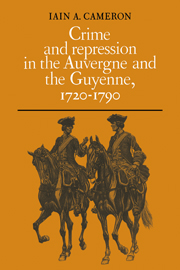Book contents
- Frontmatter
- Contents
- List of maps and table
- Preface
- Abbreviations and note on coinage
- Glossary of French terms
- Introduction
- Part I The means of repression
- Part II Crime and disorder
- Chapter 5 Theft
- Chapter 6 Violence
- Chapter 7 Rebellion and riot
- Chapter 8 The maréchaussée in Revolution, 1789–1790
- Epilogue
- Appendices
- Bibliography
- Index
Epilogue
Published online by Cambridge University Press: 05 November 2011
- Frontmatter
- Contents
- List of maps and table
- Preface
- Abbreviations and note on coinage
- Glossary of French terms
- Introduction
- Part I The means of repression
- Part II Crime and disorder
- Chapter 5 Theft
- Chapter 6 Violence
- Chapter 7 Rebellion and riot
- Chapter 8 The maréchaussée in Revolution, 1789–1790
- Epilogue
- Appendices
- Bibliography
- Index
Summary
Since 22 December 1790, the maréchaussée has been known as the Gendarmerie Nationale. It was at first sight only a change of name, a less radical reform than in 1720, when existing companies of maréchaussée had been abolished, and a new force created. Within the next few months, however, the opportunity was seized to make the crucial single change which everyone demanded: the Gendarmerie Nationale of 1791 was twice as big as the maréchaussée of 1790. To the former maréchaussée were added the old Parisian institutions which survived the 1720 Reform as well as about 4,000 entirely new recruits. The Gendarmerie Nationale therefore started with almost 11,000 men, but numbers continued to grow and the Ministry of the Interior received no more complaints about lack of police strength. Since the end of the eighteenth century the population of France has only doubled, but in 1973, the Gendarmerie Nationale had over 68,000 men, while Paris and other cities were policed by a further 120,000.
The new Revolutionary police force was divided into Divisions, most of which grouped three of the departmental companies and corresponded to the former généralité. The Guyenne became Division Seven, with its three departmental forces of Lot-et-Garonne (Agenais), Dordogne (Périgord) and Gironde (Bordelais); the Auvergne maréchaussée however was split between two divisions: Cantal (the Haute-Auvergne) joined with Lot and with Aveyron to make up Division Twenty-four and thus parted company with the Basse-Auvergne, where the Puy de Dôme, the Haute-Loire (the southern part of the Basse-Auvergne, and the Velay), and the Creuze came together to form Division Twenty-five, an administrative rearrangement which implied no obvious rationalisation.
- Type
- Chapter
- Information
- Crime and Repression in the Auvergne and the Guyenne, 1720-1790 , pp. 258 - 260Publisher: Cambridge University PressPrint publication year: 1981



